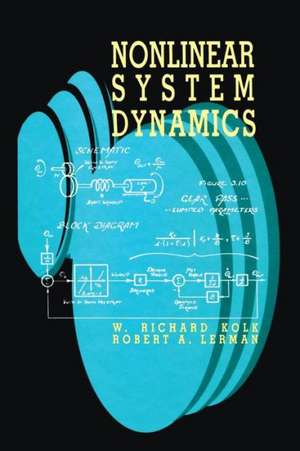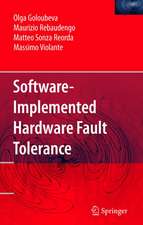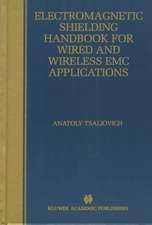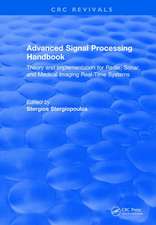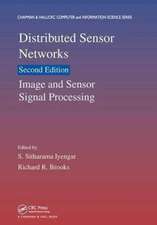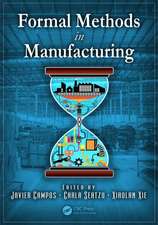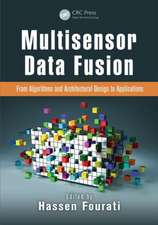Nonlinear System Dynamics
Autor W. Richard Kolk, Robert A. Lermanen Limba Engleză Paperback – 29 mar 2012
Preț: 642.83 lei
Preț vechi: 756.27 lei
-15% Nou
Puncte Express: 964
Preț estimativ în valută:
123.01€ • 129.02$ • 102.40£
123.01€ • 129.02$ • 102.40£
Carte tipărită la comandă
Livrare economică 01-15 aprilie
Preluare comenzi: 021 569.72.76
Specificații
ISBN-13: 9781468464962
ISBN-10: 1468464965
Pagini: 364
Ilustrații: X, 350 p. 60 illus.
Dimensiuni: 152 x 229 x 19 mm
Greutate: 0.49 kg
Ediția:1992
Editura: Springer Us
Colecția Springer
Locul publicării:New York, NY, United States
ISBN-10: 1468464965
Pagini: 364
Ilustrații: X, 350 p. 60 illus.
Dimensiuni: 152 x 229 x 19 mm
Greutate: 0.49 kg
Ediția:1992
Editura: Springer Us
Colecția Springer
Locul publicării:New York, NY, United States
Public țintă
ResearchCuprins
Linearity—A Shangri-La.- I.1 Why Linearity?.- I.2 From Whence Linearity.- I.3 What is Linearity?.- I.4 Things Linear or Not Linear.- I.5 Our Shangri-La.- 1 Four Interesting Equations.- 1.0 The Equations.- 1.1 The Solutions—A Preview.- 1.2 Solving Equation (i): ? + x = 0.- 1.3 Solving Equation (ii): ? + ?x? = 0.- 1.4 Solving Equation (iii): ??? + x = 0.- 1.5 Solving Equation (iv): ??? + ??? = 0.- 1.6 A Variation on Equation (iv): ??? = ???.- 1.7 Existence/Uniqueness of Solutions.- 1.8 Problems.- 1.9 References and Related Literature.- 2 Analytic Solutions to Nonlinear Differential Equations.- 2.0 Introduction.- 2.1 First-Order Base Equations.- 2.2 Second-Order Base Equations.- 2.3 The Ricatti Equation.- 2.4 Nonlinear Base Equations.- 2.5 Derivative and Integral Functional Relations.- 2.6 Matrix Nonlinear Differential Equations.- 2.7 Application to the Calculus of Variations.- 2.8 Problems.- 2.9 References and Related Literature.- 3 Linearization.- 3.0 Introduction.- 3.1 Linearizing Algebraic Functions.- 3.2 Linearizing a Transistor.- 3.3 Linearization of Differential Functions.- 3.4 Linearizing Satellite Motion.- 3.5 Concluding Example.- 3.6 Summary.- 3.7 Problems.- 3.8 References and Related Literature.- 4 The Describing Function.- 4.1 Describing Function.- 4.2 Frequency-Dependent Describing Functions.- 4.3 Digital Simulation Verifies Describing Function Analysis.- 4.4 Asymmetric Describing Functions.- 4.5 Problems.- 4.6 References.- 5 Some Properties of Nonlinear Systems.- 5.0 Introduction.- 5.1 Linear System Characteristics.- 5.2 Nonlinear Equations with Periodic Solutions.- 5.3 Limit Cycles.- 5.4 Nonlinear System Behavior.- 5.5 Some Physically Realizable Nonlinearities.- 5.6 Problems.- 5.7 References and Related Literature.-6 Liapunov Stability.- 6.0 Introduction.- 6.1 Liapunov Stability: An Overview.- 6.2 Construction of Liapunov Functionals.- 6.3 The Lur’e Problem.- 6.4 The Popov Criterion.- 6.5 Problems.- 6.6 References and Related Literature.- 7 Recursions and their Stability.- 7.1 Recursions.- 7.2 The Mechanic’s Rule.- 7.3 Singularities and Peculiarities.- 7.4 The Logistics Map.- 7.5 Recursing Differential Equations.- 7.6 Problems.- 7.7 References.- 8 Digital Simulation.- 8.0 Background.- 8.1 Recursion Formulae: Fundamental to Digital Simulation.- 8.2 The Sampling Process Creates Discrete Data.- 8.3 An Approach to Digital Simulation: Introduce Samplers.- 8.4 Concept of Pulse Filters Implicit in Digital Simulations.- 8.5 Introducing Z-Transforms.- 8.6 The Pulse Filter Now Becomes a Z-Transform.- 8.7 Introductory Example of Digital Simulation.- 8.8 Digitally Simulating a Feedback System.- 8.9 Simulating Hysteresis Due to Backlash in Gears.- 8.10 Simulating a System with Hysteresis.- 8.11 Problems.- 8.12 References.- 9 Spreadsheet Simulation—A Tutorial.- 9.1 Introduction.- 9.2 Use of the “Copy” Command.- 9.3 Using the Graph Command.- 9.4 Summary.- 9.5 Some Heuristic Exercises—Brief Descriptions.- 9.6 Suggested Solutions to the Exercises.- 9.7 References.- 10 An Isobaric Cabin Pressure Control.- 10.0 Introduction.- 10.1 Background.- 10.2 How the Cabin is Pressurized.- 10.3 Basic Numbers and Constraints.- 10.4 Cabin Dynamics.- 10.5 Design Evolution.- 10.6 A Nonlinear Digital Simulation.- 10.7 Limiting Cabin Pressure Rate.- 10.8 Initializing Integrators.- 10.9 Problems.- 10.10 References and Related Literature.
